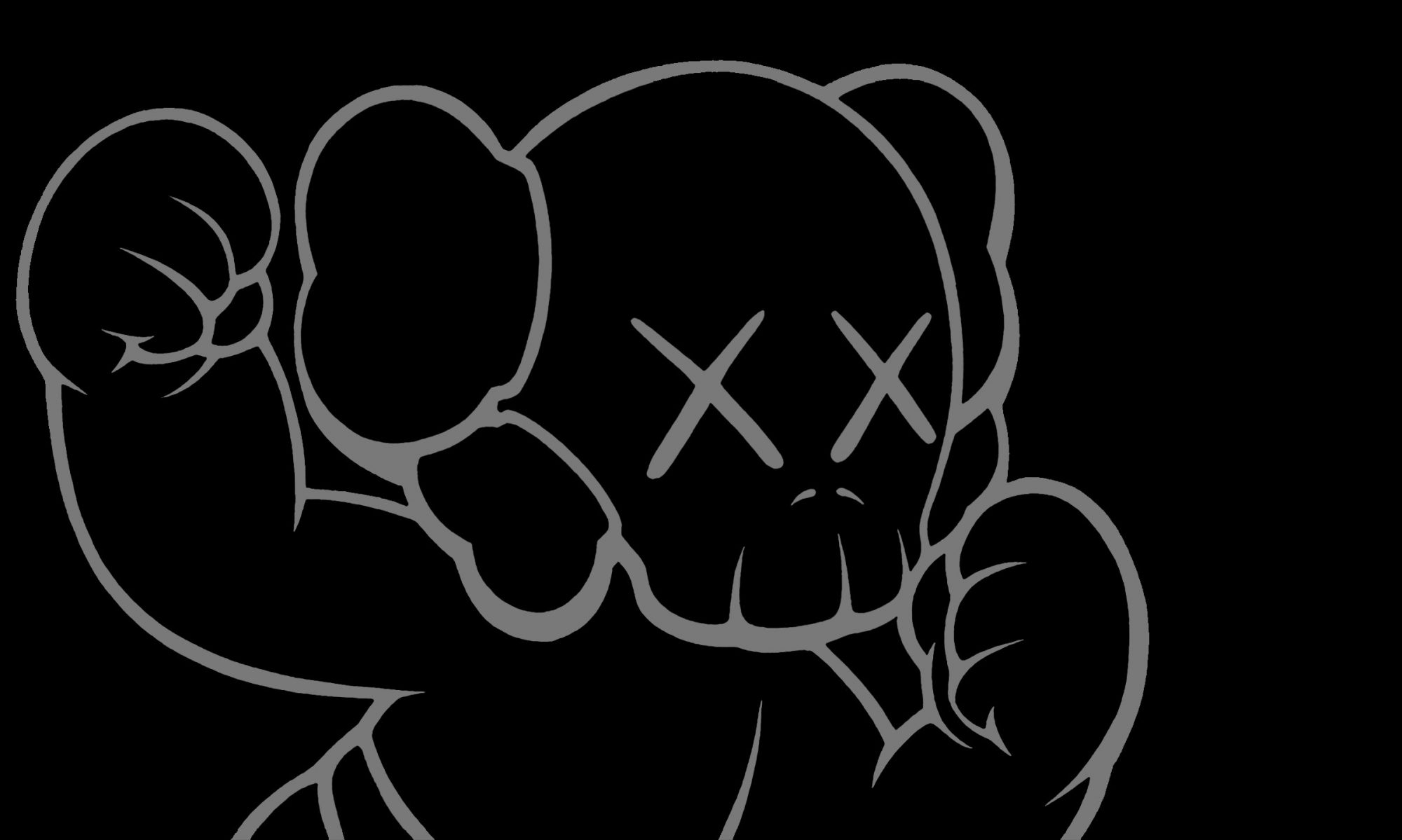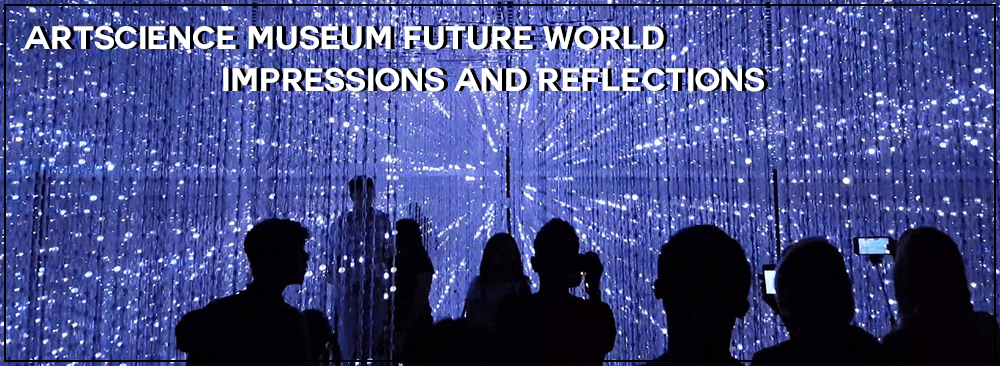Introduction
ArtScience Museum Future World is a themed gallery filled with futuristic interactive artworks, located beside the Marina Bay Sands. The entire exhibit is filled with the world of art, science, magic, and metaphor through a collection of cutting-edge digital installations. This interactive space is collaborated with teamLab, a renowned interdisciplinary art collective.
I’ll be doing an overview of the whole setup, while also selecting a few exhibits within the gallery which I found really interesting, together with photos and videos I took during my visit. Also, I’ll be identifying the interactivity components being used in those setups that I’ll be talking about, so as to aid me in my future works and to give me more inspirations and ideas.
Future World takes visitors on an exciting journey of discovery through these four key narratives:
1. City in A Garden
2. Sanctuary
3. Park
4. Space
City in A Garden
Brief
City in A Garden takes inspiration from Singapore, where urban structures and nature co-exist harmoniously and demonstrates how essential nature’s resources are to people. Nature’s nurturing embrace allows for people to thrive, cultivating their creative impulses, allowing for the production of art, science, and technology.
The following are some notable installations that I will be talking about:
1. Inverted Globe, Giant Connecting Block Town
This was the first installation that caught my attention. It was located inside a secluded room after walking through a dimly lit walkway. Outside the walkway, I wasn’t able to see anything, but there were sounds projecting from the inside which lured me in.
Once I entered the room, I was surprised to see the entire space being projected with colourful and popping visuals, definitely not what I would expect after walking through that dark walkway.
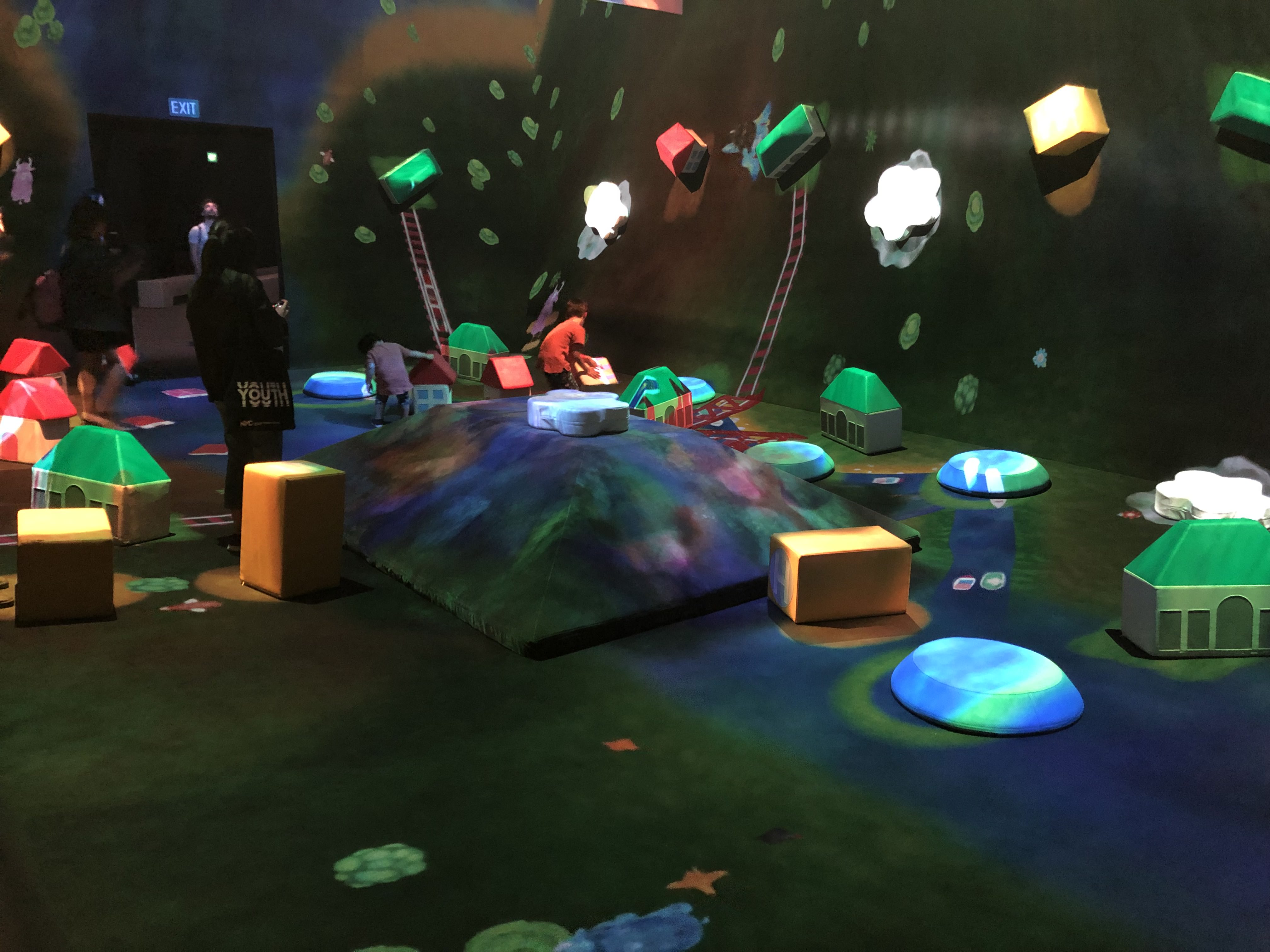
There were movable objects on the ground, which were meant to be moved around to reconstruct the route. Here is a video of me and Ashley playing with the objects:
This interactive artwork reacts to our input and ultimately develops into a vibrant, thriving cityscape. The moving cars, trains, planes, and boats were projected around the whole room on all four walls, which makes the experience very immersive.
Notable interactivity components: Projection & Sound.
2. Sketch Aquarium
This I would say, is the most famous work in the entire exhibit.
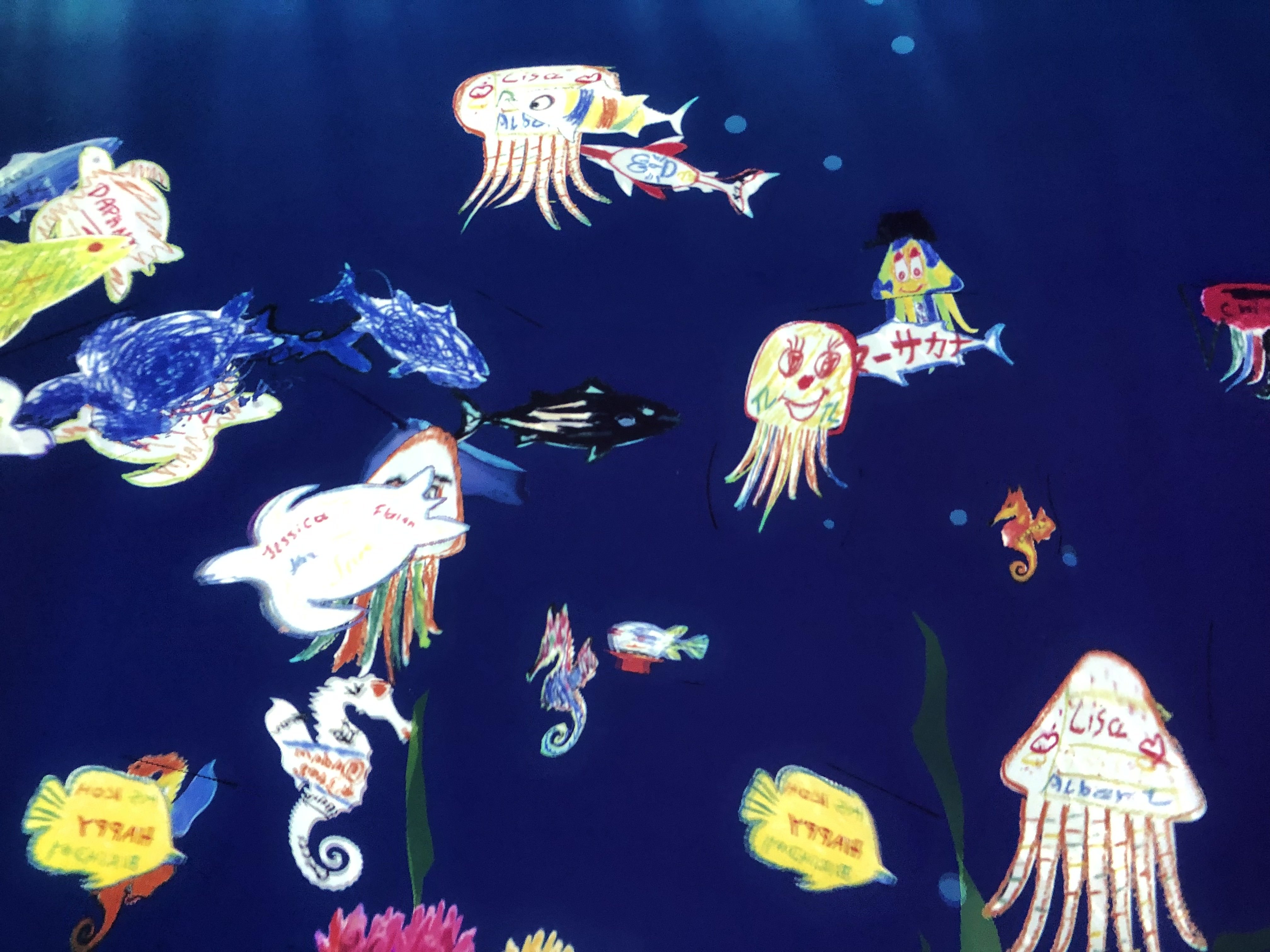
This iconic installation features a digitally rendered, aquatic world of underwater animals. Participants of all ages use their imaginations to create fantastic and colorful sea creatures on paper.
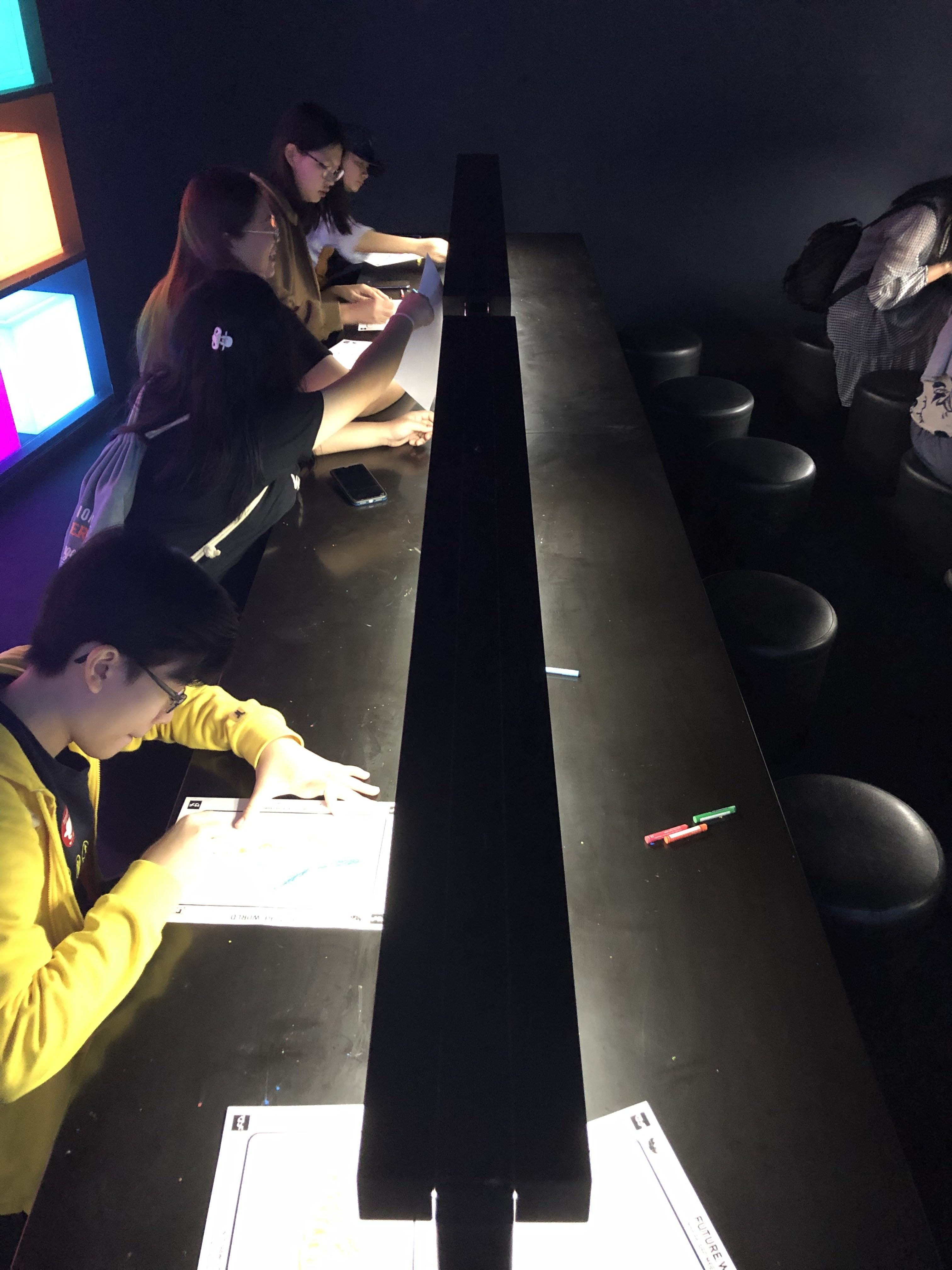
They are then digitally scanned and brought to life to swim freely in the aquarium where they live.
The crowd around this installation is undeniably the most as compared to the others, and I do see a reason why. Size does matter a lot in an installation, as humans we get drawn to things which are big scale. Here is Since the projection is huge, roughly 5m high and 20m wide, most of the visitors are intrigued and captivated by the whole setup.
This interactive art made use of Do-It-With-Others (DIWO), a joint project development model that enables like-minded people to collaboratively work on a task. Without the visitors’ drawings, there would be no underwater animals, which defeats the whole purpose of this setup.
* Refer to this post as I shared a little more about what DIWO is:
Y2S1 | Interactive Media 1 | Inspiring Example of Interactive Art | Rhythm 0
Upon closer look at the underwater animals that were drawn by the visitors, I saw one that was standing out.
There was one octopus with the words “FREE HK”. In the midst of the current Hong Kong protest happening right now for almost 3 months, it is no surprise to see such portrayal of messages appearing there and then. I would consider this as protest art through collaborative work (the artist and the audience). Although I was slightly taken aback when I saw this, this made me ponder about how art is able to influence society, or even show underlying communication to the world through methods like this.
This reminded me of a work called “The Knitted Radio”, a project developed in collaboration with Irene Posch at Eyebeam Art + Technology Center in New York in 2014.

It is part of an ongoing investigation towards using traditional textile crafting techniques to create electronic components and devices from scratch. The tactile piece manifests how to knit a sweater that is also an FM radio transmitter. By equipping the wearer with the ability to occupy electronic space, the casual knitwear intends to inspire local, free communication structures. The experiment is dedicated to the diverse crowd involved in recent Gezi Park protests in Taksim Square, Istanbul.
Here is a link to understand The Knitted Radio further:
Sounds similar, right? Using art to protest silently, with the help of interaction through technology.
Notable interactivity components: DIWO & Magnitude.
3. Sliding through the Fruit Field
Sliding through the Fruit Field is a playful and colourful interactive artwork designed for children that is projected onto a newly-designed slide. They first climb the stair to reach the peak before sliding down the stairs.
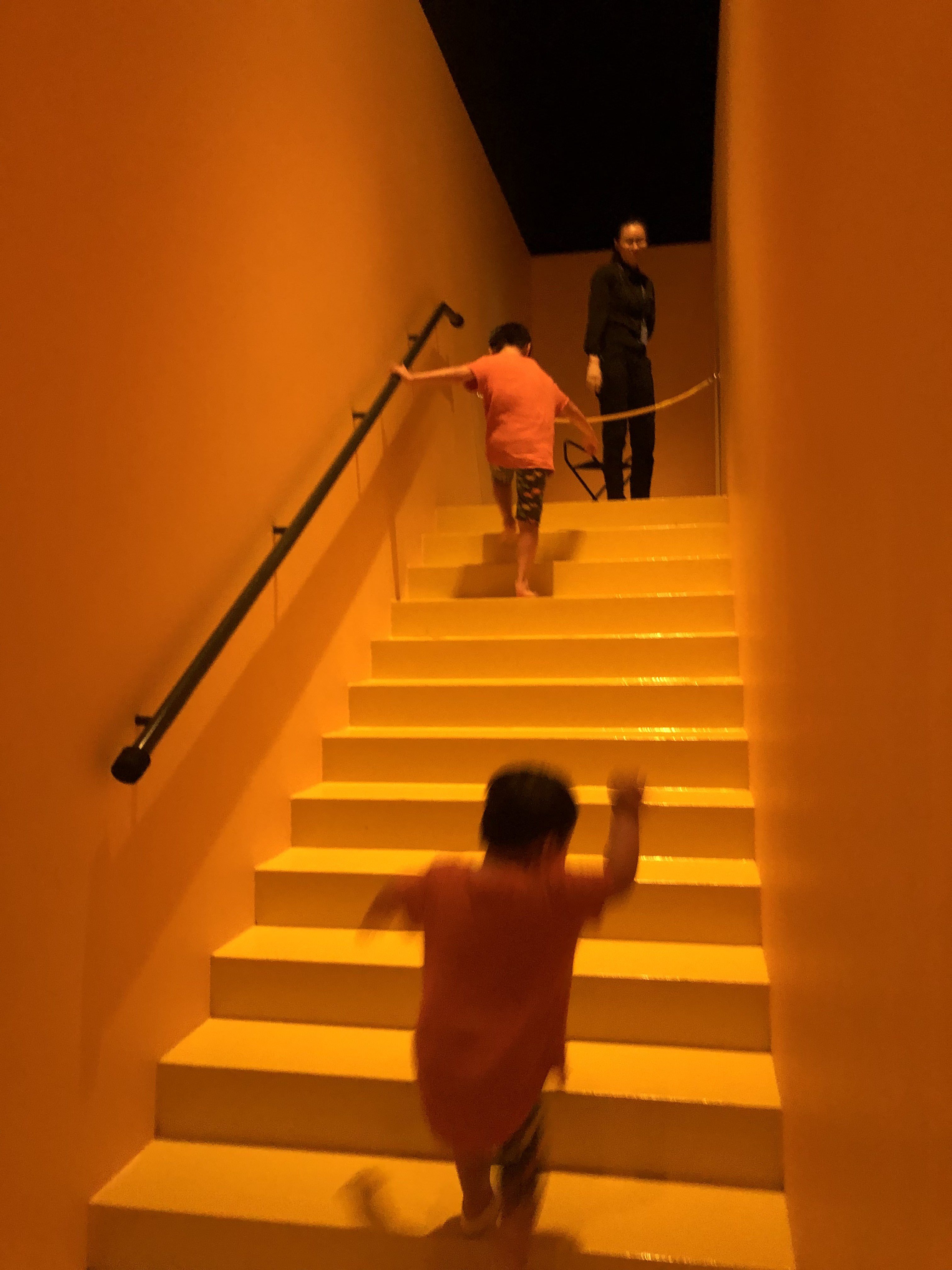
Visitors become a beam of life-giving sunlight, and as they glide down the slope, their energy is transferred to the fruit field, causing flowers and fruit to blossom and grow. As the different elements interact in the field, new seeds are sown, leading to new life.
This was undeniably the one the kids loved the most. To be honest, there were no adults in this segment at all. The notion of sliding down the slide is surely a fun thing to do for all children, and I am sure that was what the artist wanted to achieve as well, judging from the last paragraph of the artwork label “Hey kids,” (pardon for the blur picture, it was dark inside the exhibit…)
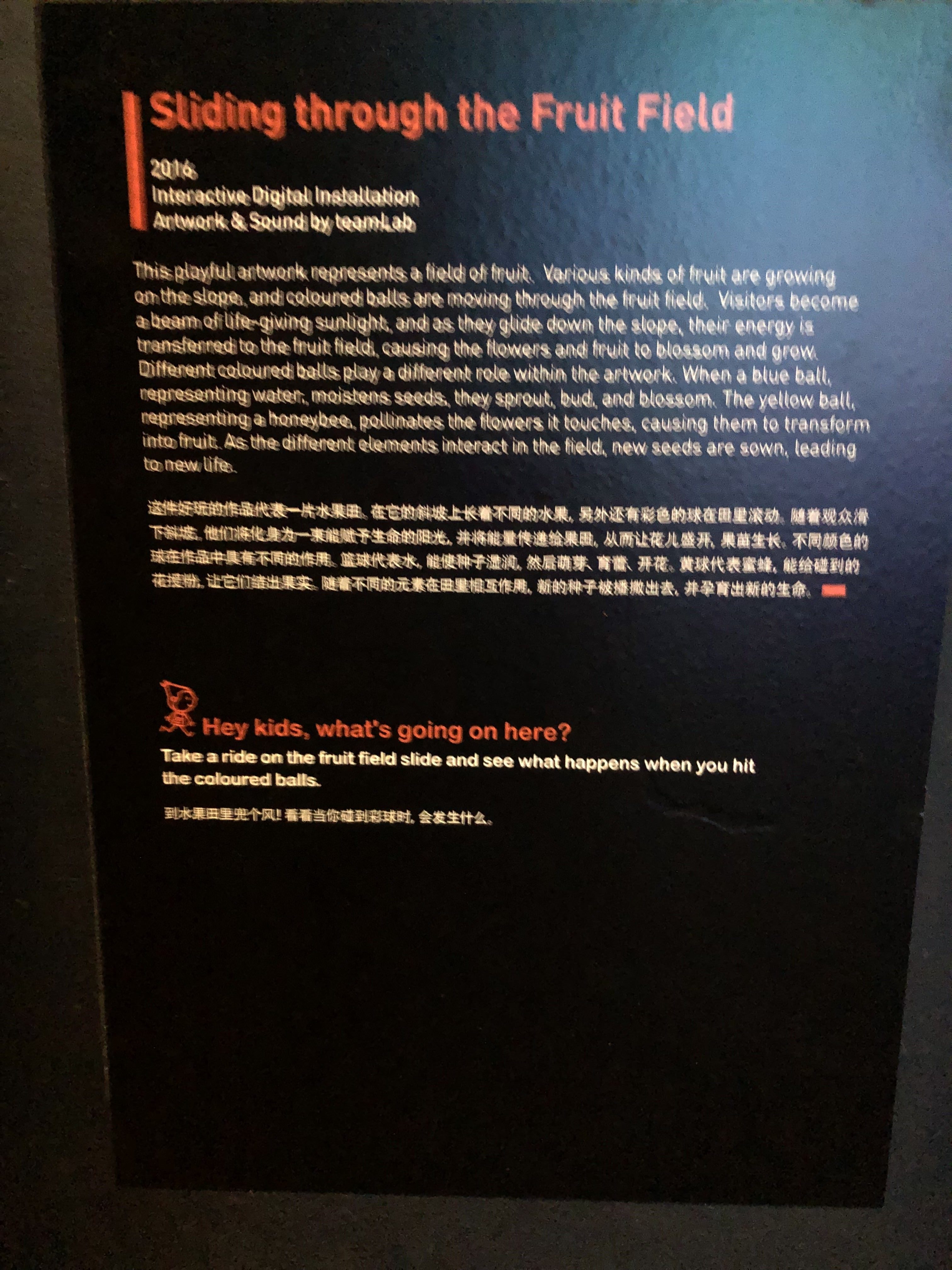
I guess the concept of play is essential when it comes to creating an interactive artwork that wishes to involve and attract the younger crowd, and the artist has succeeded in doing so.
Notable interactivity components: Play.
Santuary
Brief
Away from the hustle-bustle of City in a Garden, enter into an idyllic digital wonderland for a moment of tranquility. Sanctuary is the oasis of calm in the center of Future World.
The following is the only installation in Santuary:
Impermanent Life: People Create Space and Time, at the Confluence of their Spacetime New Space and Time is Born
This installation, depicts cherry blossoms blooming and scattering, playing out the cycle of life and death. The existence of both human and nature is impermanent, because, no state, good or bad, lasts forever. A circle is born from our feet and radiates at a certain rhythm.
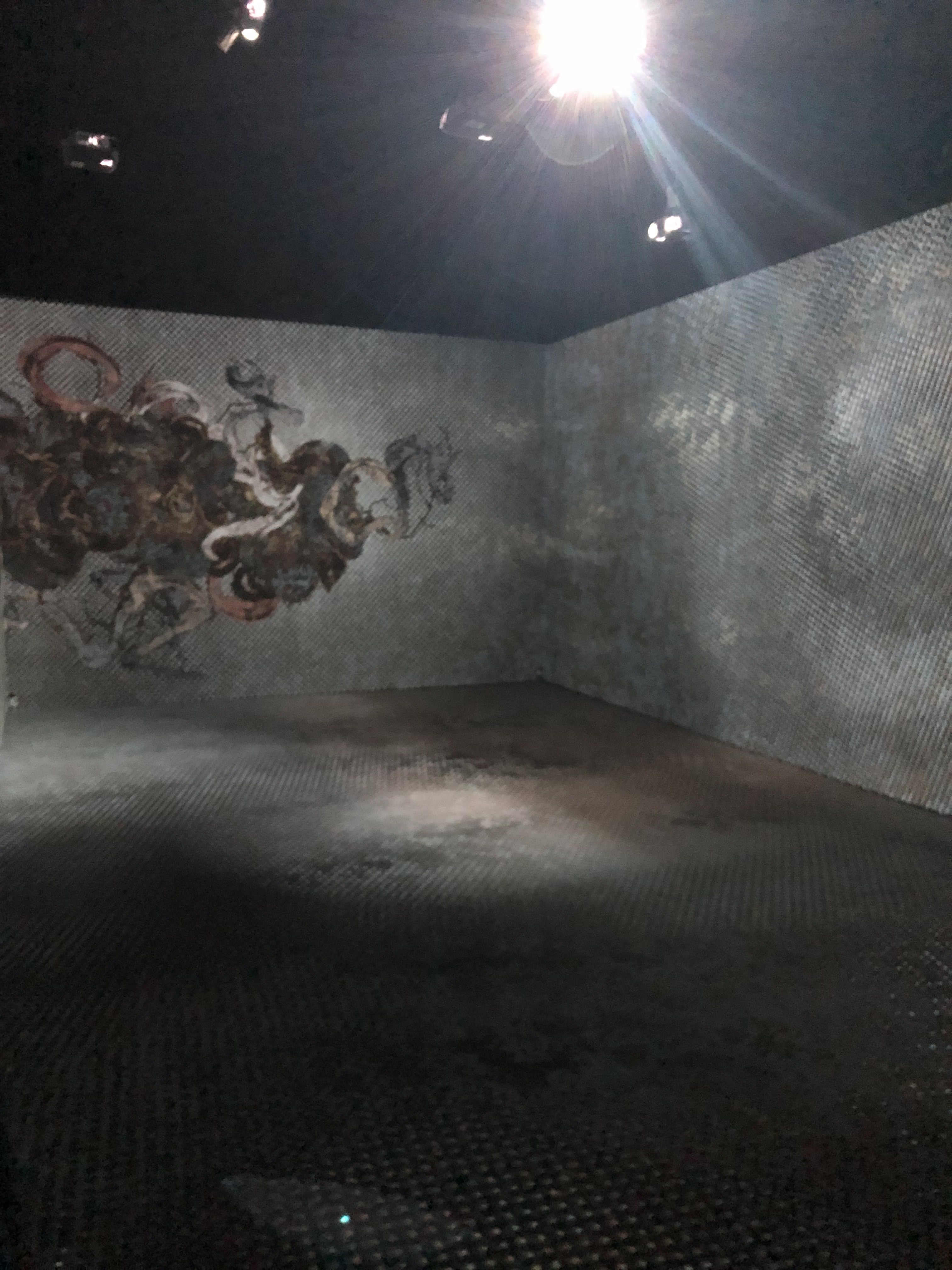
I went in for roughly 10 minutes, to see who would come in and stay as well. With no surprise, kids that enter this space lasted for not more than even 5 seconds. This installation provides the perfect environment for reflection and meditation, something which kids would not be able to appreciate.
I felt that this was a really nice setup. Amongst all the colourful and loud installations in the whole exhibit, this setup was the one that was the direct opposite of what we would have expected. Depending on the state of the environment, the circles created can either provide light or darkness to the entire space.
The background lo-fi music, together with the slow animation of the projection, gives a harmonious and peaceful feeling to the whole environment. This artwork is calm, but reactive at the same time. I feel that this is something that is not easy to achieve for an artwork, but the artist has managed to do so.
Notable interactivity components: Sound & Momentum.
Park
Brief

Only when there is participation amongst the visitors, then the Light Ball Orchestra would be able to send out ripples in different directions to interact with others. By working together through pushing, bouncing and rolling the balls to continuously change the composition, color, and sound of the orchestra, this is another example of DIWO being used, which is often seen in many interactive artists’ works.
Notable interactivity components: Light & Sound.
2. Sketch Town
This installation is a depiction of a fictitious town, based on Singapore that includes recognizable landmarks, such as, ArtScience Museum, the Merlion and the Singapore Flyer.

This is super similar to sketch aquarium, whereby the visitor would use crayons and paper to draw a building, a car, or a plane for Sketch Town, and see how their urban design becomes part of a vast projected city.
The only difference is that we could physically interact with the projection through touch and movement, bringing the town to life. Touch a car, for example, and it will speed up, or change direction, as seen in the following video:
A little too underwhelming for this installation in my opinion as it was pretty similar to Sketch Aquarium, and I felt that Sketch Aquarium had more impact on me due to its large magnitude.
Notable interactivity components: The same as Sketch Aquarium, less magnitude.
Space
Brief
This marks the end of any visitors’ journey in the whole exhibit on a note of wonder by embarking outward and upward into astronomical Space.
There is only one installation called Crystal Universe in Space, which immersed me in what has been the subject of dreams, mythologies, artistic visions and scientific exploration since the dawn of human history.
Crystal Universe
This is undoubtedly my favorite installation in this exhibit!
Behold a seemingly infinite number of light particles inside the scintillating Crystal Universe. This stunning artwork is created with teamLab’s Interactive 4D Vision technology and over 170,000 LED lights, giving the illusion of stars moving in space. Move beyond the stars, and I start to encounter astrophysical phenomena such as planets, galaxies, and even gravitational waves.

I surrounded myself amongst the vastness of the cosmos, and it just feels so surreal. It is amazing just how LED lights are able to do such wonders. I must say the number of LED lights being used is a huge factor for the success of this installation.
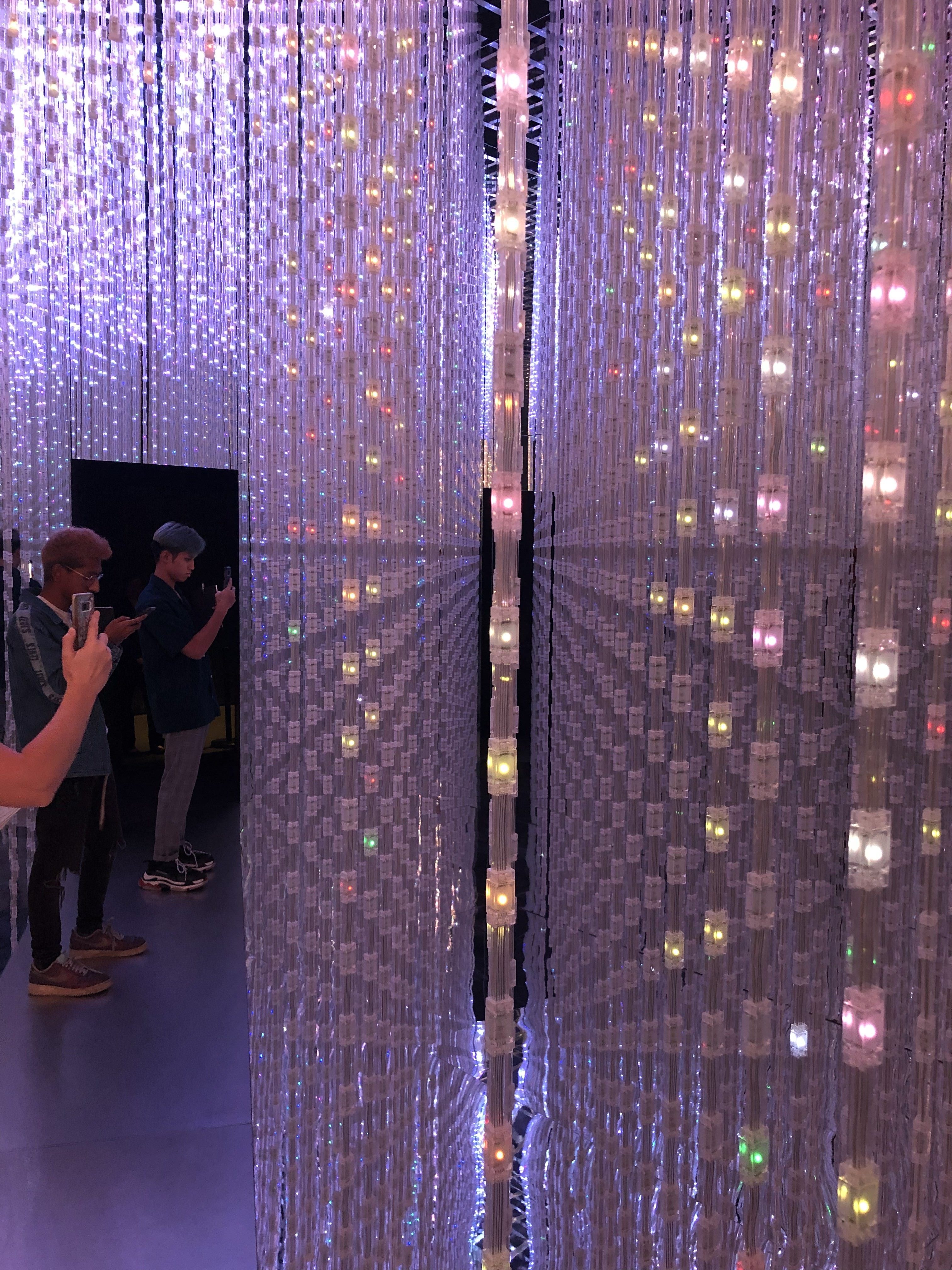
I’m also quite sure that this might be the most expensive installation, given the amount of money spent on all that 170,000 LED lights. It is amazing how everything is aligned so neatly and in order, which makes the setup so clean and organized.
It has a very simple interactivity: the light and body of the installation respond to our mass and motion, and the fabric of the universe changes by ‘swiping’ astrological phenomenon from smart devices within the installation. And that’s it, we just enjoy and watch them become part of the dazzling environment around us.
Not only does this setup look good on the inside, it was even more beautiful looking from the outside.
Truly a great work of art- strongly possessing both interactivity and aesthetics at the same time.
Notable interactivity components: Quantity & aesthetics.
Conclusion
It was an eye-opener to have a chance to visit this exhibit. I didn’t manage to join my class previously for the INTER-MISSION Interactive Project and I am glad I could make it for this visit.
Not going to lie, I have not visited the ArtScience Museum before, so this was my very first time and it was a wonderful experience. It has certainly given me a lot of inspiration and ideas for my future works, and I can’t wait for Future World’s next exhibit!
